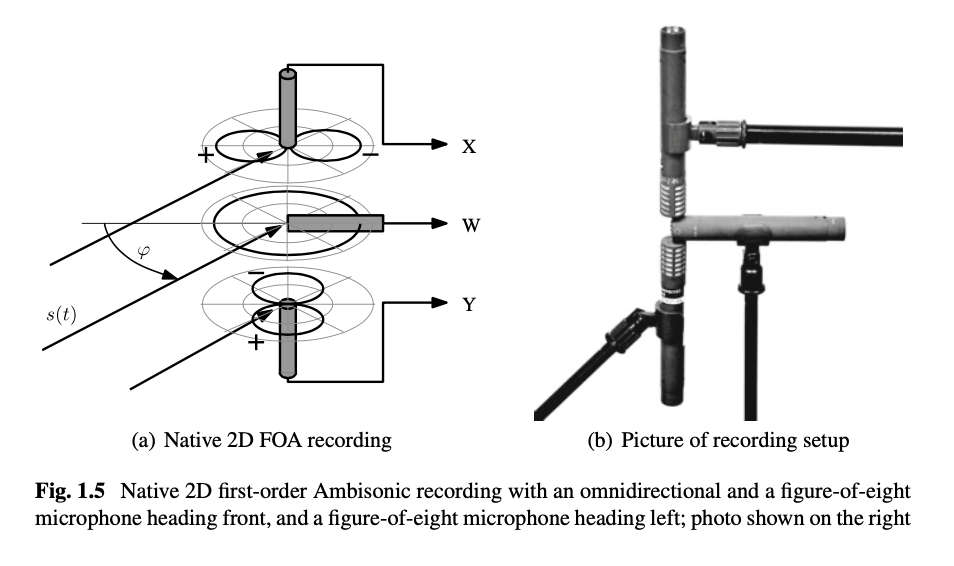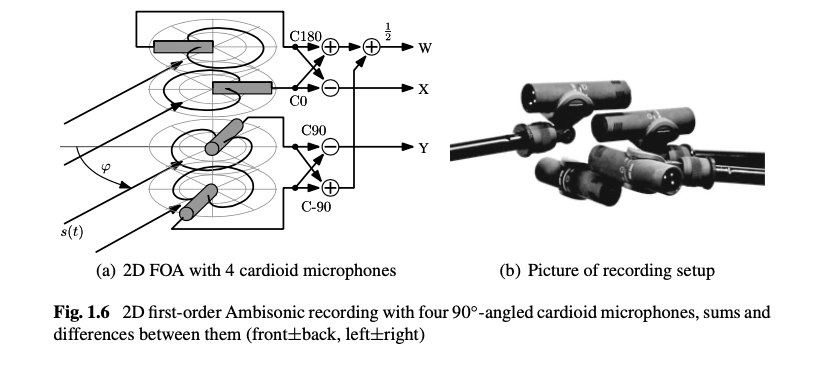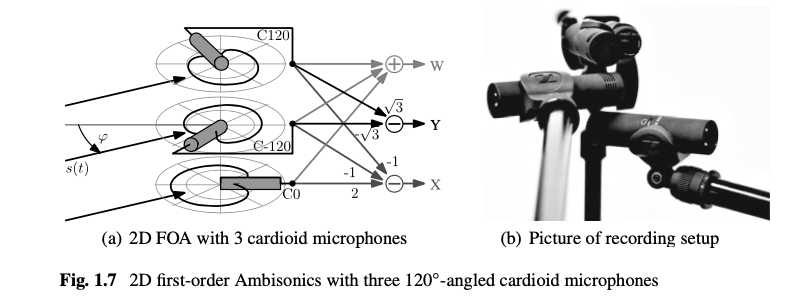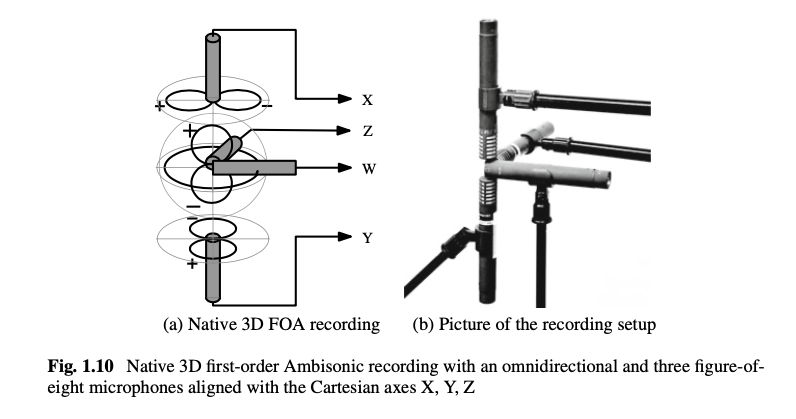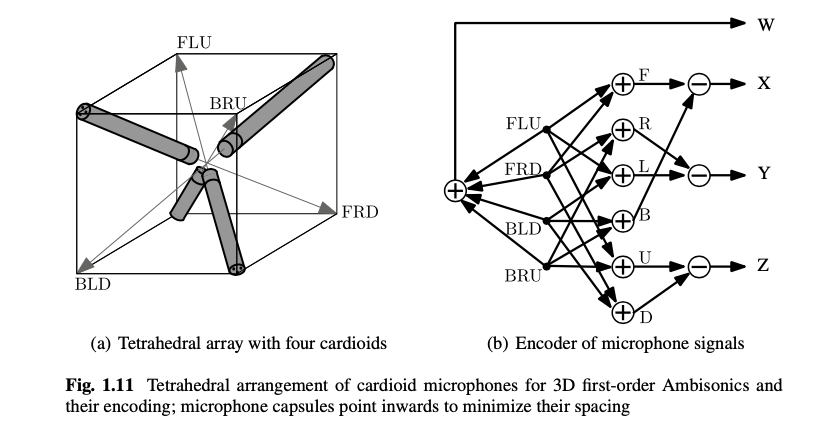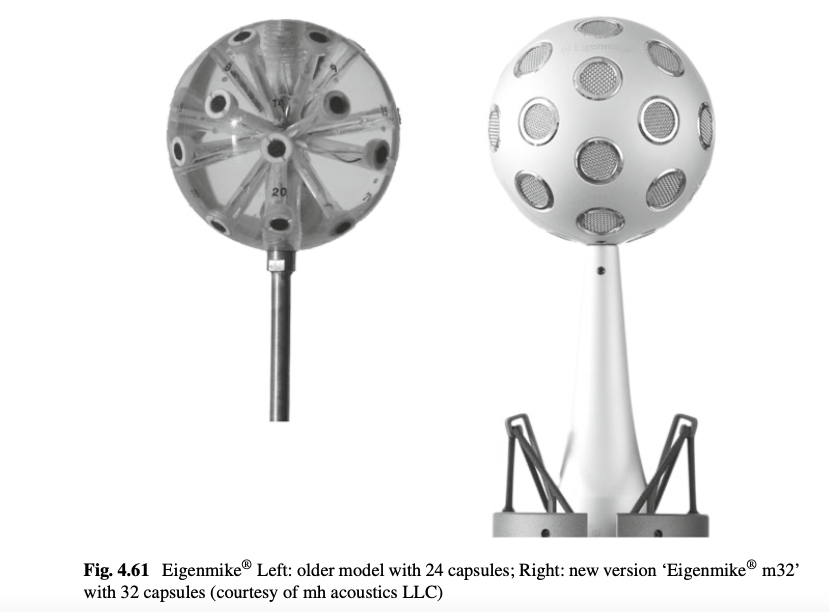First-Order Ambisonics (FOA) ref: The Double Mid-Sides Array
Double Mid-Side (DMS) extends the classic MS pair by adding a rear-facing cardioid. The three coincident capsules provide:
M_front: forward cardioid capturing direct sound.M_rear: backward cardioid providing ambience behind the array.S: side-facing figure-8 that measures left/right pressure differences.Simple matrixing turns these feeds into the horizontal FOA channels: W comes from the sum of M_front and M_rear, X from their difference, and Y from the side figure-8. Adding an up/down figure-8 capsule (Triple MS) contributes the Z channel for full-sphere FOA while keeping the array phase-coincident.
Native 2D Ambisonic recording (Double-MS)
Matrix the forward and rear cardioids for W and X, and keep the side figure-8 for Y. Precise gain matching keeps the derived patterns orthogonal.
2D Ambisonic recording with four 90◦-angled cardioids
Four 90° cardioids can be decoded to FOA by summing opposite capsules for W and differencing for X and Y. This is common on broadcast rigs that lack figure-8 options.
2D Ambisonic recording with three 120◦-angled cardioids
Three 120° cardioids form an equilateral cluster; with appropriate weighting they approximate the FOA horizontal components when a rear-facing capsule is impractical.
Native 3D Ambisonic recording (Triple-MS)
Triple MS is Double MS plus a vertical figure-8 capsule, yielding the Z component required for full-sphere FOA capture.
3D Ambisonic recording with a tetrahedral arrangement of cardioids
A tetrahedral cardioid cluster (e.g., Soundfield or Ambeo) outputs four A-format signals that are later converted to the B-format W, X, Y, Z channels.
Higher-Order Ambisonics (HOA) Higher orders sample additional spherical harmonics; an order-N recording carries (N + 1)^2 channels, improving localization at the cost of more capsules and processing power.
Eigenmike®
Sound Demos - listen with headphones, we’ll listen to some in studio B later.
The 32-capsule Eigenmike captures up to fourth-order Ambisonics (25-channel B-format) from a single phase-coincident array.
Octomic Octomic
Core Sound’s OctoMic uses eight cardioid capsules to deliver native second-order Ambisonics, providing cleaner pattern separation than tetrahedral FOA arrays while remaining portable.
Zylia ZM-1
Zylia’s 19-capsule ZM-1 captures third-order Ambisonics and ships with software for beamforming, binaural rendering, and flexible virtual microphone pattern design.
Sennheiser AMBEO VR Mic AMBEO VR Mic
Compact tetrahedral cardioid array that outputs A-format signals and includes an Ambisonic plug-in to convert to B-format (AmbiX or FuMa). Rugged and widely supported in DAWs for FOA field capture.
Zoom H3-VR H3-VR 360-degree Recorder
All-in-one FOA recorder with onboard tetrahedral mic, integrated Ambisonic decoding/encoding, and six-axis gyro that tracks orientation for post alignment–ideal for quick VR ambience beds.
RODE NT-SF1 NT-SF1
Studio-grade SoundField-designed tetrahedral condenser aimed at music and film work; supplied SoundField plug-in offers adjustable virtual patterns and precise B-format output for FOA workflows.
